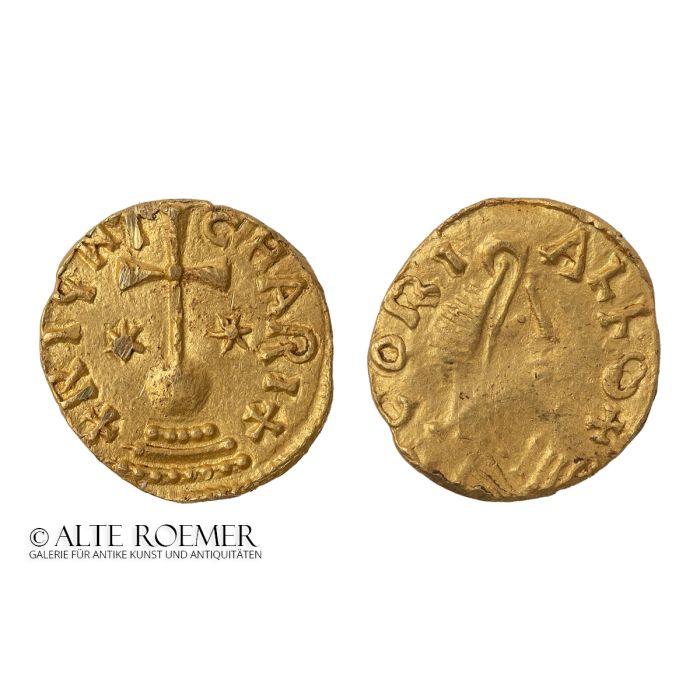Very rare Merovingian gold tremissis in perfect condition with known finding location
€4,400
available
Object number
AR3341
| Coined by: |
Anonymous (so-called "Mint and Moneyer" series) Moneyer: Rignicharius |
| Value: |
Tremissis (one third of a Solidus)
|
| Material: |
Gold
|
| Details: |
Diameter: 12.3 mm, weight 1.39 Gramm. Coriallum (Cherbourg) mint, 580-670 A. D. |
| Obverse: |
CORIALLO+ Diademed profile bust right. |
| Reverse: |
+RIGNI CHARI Latin cross on a globe above three concave lines, the top and bottom formed of pellets, the middle formed of a plain line with a pellet at each end; star either side of cross. |
| Condition |
Near "as struck", minor surface scratches.
|
| References: |
A. De Belfort, Description generale des monnaies merovingienne (Paris 1892), vol. 1, S. 467, Nr. 1639 M. Prou, Les monnaies merovingiennes (Paris 1892), S. 71 Taf. V Nr. 21, Referenznummer 302 |
| Rarity and type: |
Very rare coins from the last century of Merovingian gold coinage. According to PAS the first find of such a coin type in the UK every. The only known specimen on the market since as to our best knowledge. In the second half on the 6th century AD, naval warfare and piracy effectively throttled the influx of Byzantine gold to what is now the lower Rhone area in modern South France. Therefore, local mints were created and byzantine gold coins pulled from circulation and "recycled", such that latest in the 590s AD hardly any byzantine Solidus was in circulation in this area. The coinage was characterized by the name of mint on one and the name of the moneyer on the other side, which gave it the denomination "Mont and Moneyer" series in modern numismatics. Around 674 AD the gold coinage was replaced by the silver denier. For a very detailed discussion of the late Merovingian gold coinage we recommend the article by D.M. Metcalf, Monetary circulation in Merovingian Gaul, 561-674. A propos des Cahiers Ernest Babelon, 8 (Revue Numismatique, 2006), pp. 337 - 393. |
| Provenance: |
Acquired 2022 at a British auction house. Found October 24, 2021, in Horncastle area, East Lindsey, Lincolnshire, UK. The find was reported by the finder to the authorities, registered at the Portable Antiquities Scheme under the reference LIN-504982, and thereafter returned to the finder who put the rare coin on auction. An export permit was issued by the British authorities.
|
| Authenticity: |
We unconditionally guarantee the authenticity of every artefact, all items are subject to our lifetime return policy on authenticity.
|


